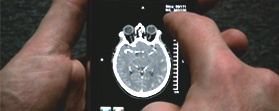 The evidence is building that smartphones are suitable for remote viewing of medical images by consulting specialists. The latest comes from the Mayo Clinic Telestroke Network in Arizona, which found that the ResolutionMD Mobile smartphone app, from Calgary Scientific, was adequate for evaluating remotely located stroke patients.
The evidence is building that smartphones are suitable for remote viewing of medical images by consulting specialists. The latest comes from the Mayo Clinic Telestroke Network in Arizona, which found that the ResolutionMD Mobile smartphone app, from Calgary Scientific, was adequate for evaluating remotely located stroke patients.
"CT head interpretations of telestroke network patients by vascular neurologists using ResolutionMD on smartphones were in excellent agreement with interpretations by spoke radiologists using a picture archiving and communications system and those of independent telestroke adjudicators using a desktop viewer," concludes a study published in the October issue of the American Heart Association journal Stroke.
"Essentially what this means is that telemedicine can fit in our pockets," Mayo Clinic Telestroke Medical Director Dr. Bart Demaerschalk says in a Mayo press release. "For patients this means access to expertise in a timely fashion when they need it most, no matter what emergency room they may find themselves."
Mayo Clinic neurologists in Phoenix can remotely consult with emergency departments at 12 rural hospitals, mostly in Arizona, that have fixed telemedicine platforms or telemedicine robots. Typically, the stroke specialists have face-to-face video chats with remote ED physicians and view brain scans on a standard desktop or laptop PC to look for signs of hemorrhage or blocked arteries.
For this study, the Mayo neurologists and radiologists at Yuma (Ariz.) Regional Medical Center compared brain scans for 53 patients on traditional PACS displays and with the FDA-cleared ResolutionMD app. The reviewers were in agreement on 92 to 100 percent of what are considered the most important radiological features, according to the report.
Quick diagnosis of stroke and administration of clot-busting drugs can save lives and the remote nature of the telestroke interventions help prevent costly, dangerous patient transfers by ambulance or airlift from rural facilities to urban trauma centers. Being able to make accurate diagnoses from mobile devices can save even more precious time when on-call neurologists are not in front of a PACS station.
"If we can transmit health information securely and simultaneously use the video conferencing capabilities for clinical assessments, we can have telemedicine anywhere, which is essential in a state like Arizona where more than 40 percent of the population doesn't have access to immediate neurologic care," Demaerschalk says.
For more, watch this video of Demaerschalk explaining the study.
















